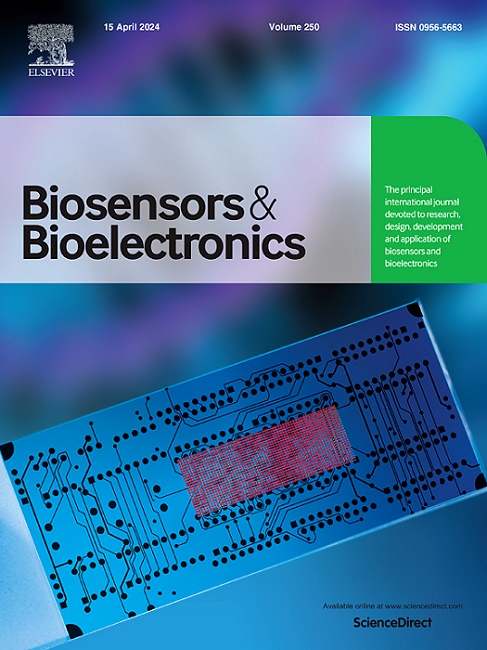一种电容式生物传感器,用于前列腺癌的正常尿液细胞外囊泡检测
IF 10.5
1区 生物学
Q1 BIOPHYSICS
引用次数: 0
摘要
细胞外囊泡(EVs),特别是外泌体,在细胞间通讯中起着重要作用,可以在生物液体中找到。不可避免地,电动汽车已经成为癌症诊断的有前途的生物标志物。在尿液中检测ev比在血液中检测更具侵入性。然而,由于尿液中EV浓度低且缺乏标准化,可靠的EV定量仍然具有挑战性。在此,我们介绍了一种基于电容的电化学生物传感器,用于两种EV标记,CD63和前列腺特异性膜抗原(PSMA) -前者是所有外泌体中存在的通用标记,后者是前列腺癌(PCa)标记。集成电容技术(非法拉第阻抗)提供了高灵敏度和无试剂的技术能力,非常适合即时诊断。对于传感器的制造,硫代CD63和PSMA适配体在还原氧化石墨烯和二硫化钼(rGO/MoS2)修饰的丝网印刷碳电极(SPCE)上自组装。从ev分离的样品中加入10 μL,在10 min内得到结果。在最佳条件下,PSMA和CD63的检测限分别为4.83 × 102和1.47 × 103 EV/μL。为了验证该传感器,使用该传感器对尿液EV样本进行了分析。结果显示与商用PSMA ELISA有很强的相关性。此外,PSMA/尿肌酐(uCRE)水平可以区分PCa患者和健康对照,表明其作为一种非侵入性诊断工具的适用性。总体而言,该传感器为尿液EVs检测提供了一种简单、快速、无试剂、更可靠的检测技术,以提高前列腺癌的诊断。本文章由计算机程序翻译,如有差异,请以英文原文为准。

A capacitance biosensor for prostate cancer detection via normalised urinary extracellular vesicles
Extracellular vesicles (EVs), and in particular exosomes, play an important role in intercellular communication and can be found in biological fluids. Inevitably, EVs have emerged as promising biomarkers for cancer diagnosis. Detecting EVs in urine is less invasive than blood. However, reliable EV quantitation in urine is still challenging due to low EV concentration and lack of standardisation. Herein, we introduce a capacitance-based electrochemical biosensor for two EV markers, CD63 and prostate-specific membrane antigen (PSMA) – the former being a generic marker present in all exosomes and the latter a prostate cancer (PCa) marker. Integrating a capacitance technique (non-Faradaic impedance) provides highly sensitive and reagent-free technique capabilities ideal for point-of-care diagnosis.
For the sensor fabrication, both thiolated CD63 and PSMA aptamers were self-assembled on reduced graphene oxide and molybdenum disulfide (rGO/MoS2) modified screen-printed carbon electrodes (SPCE). The results can be obtained in 10 min using 10 μL from EVs isolated sample. Under optimal conditions, the associated PSMA and CD63 detection limits are 4.83 × 102 and 1.47 × 103 EV/μL, respectively, without any additional signal amplification steps. To validate the sensor, urinary EV samples were analysed using the sensor. The results showed a strong correlation with a commercial PSMA ELISA. Additionally, the PSMA/urine creatinine (uCRE) level can differentiate between PCa patients from healthy controls, indicating its applicability as a non-invasive diagnosis tool. Overall, the developed sensor provides a simple, fast, reagent-free, and more reliable detection technique for urinary EVs detection to improve PCa diagnosis.
求助全文
通过发布文献求助,成功后即可免费获取论文全文。
去求助
来源期刊

Biosensors and Bioelectronics
工程技术-电化学
CiteScore
20.80
自引率
7.10%
发文量
1006
审稿时长
29 days
期刊介绍:
Biosensors & Bioelectronics, along with its open access companion journal Biosensors & Bioelectronics: X, is the leading international publication in the field of biosensors and bioelectronics. It covers research, design, development, and application of biosensors, which are analytical devices incorporating biological materials with physicochemical transducers. These devices, including sensors, DNA chips, electronic noses, and lab-on-a-chip, produce digital signals proportional to specific analytes. Examples include immunosensors and enzyme-based biosensors, applied in various fields such as medicine, environmental monitoring, and food industry. The journal also focuses on molecular and supramolecular structures for enhancing device performance.
 求助内容:
求助内容: 应助结果提醒方式:
应助结果提醒方式:


